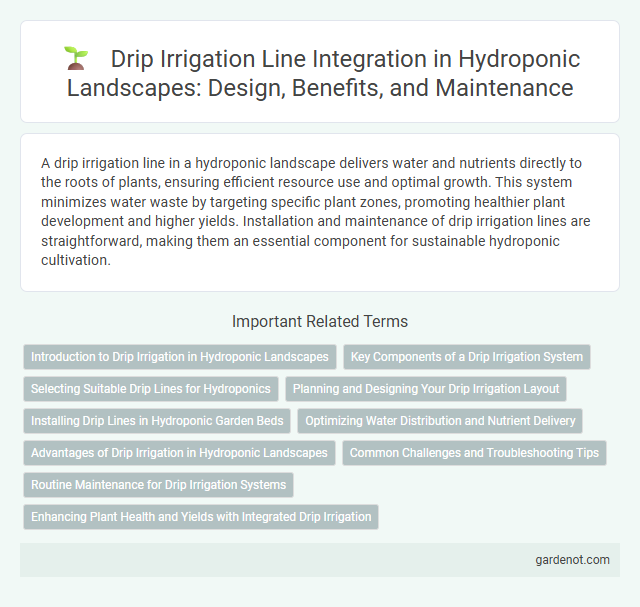A drip irrigation line in a hydroponic landscape delivers water and nutrients directly to the roots of plants, ensuring efficient resource use and optimal growth. This system minimizes water waste by targeting specific plant zones, promoting healthier plant development and higher yields. Installation and maintenance of drip irrigation lines are straightforward, making them an essential component for sustainable hydroponic cultivation.
Introduction to Drip Irrigation in Hydroponic Landscapes
Drip irrigation lines deliver precise water and nutrient solutions directly to plant roots in hydroponic landscapes, optimizing resource efficiency and promoting healthy growth. This system reduces water waste and minimizes nutrient runoff by maintaining consistent moisture levels tailored to each plant's needs. Incorporating drip irrigation ensures uniform distribution, enhancing crop yield and reducing labor associated with manual watering.
Key Components of a Drip Irrigation System
Key components of a drip irrigation system in hydroponic landscapes include the main water source, pressure regulator, filter, drip tubing, emitters, and end caps. The pressure regulator ensures consistent water flow, while filters prevent clogging by removing debris. Emitters deliver precise water amounts directly to plant roots, optimizing nutrient absorption and conserving water.
Selecting Suitable Drip Lines for Hydroponics
Selecting suitable drip irrigation lines for hydroponic landscapes requires prioritizing materials resistant to chemicals and UV exposure, such as polyethylene or PVC. Emitters with adjustable flow rates between 2 to 4 liters per hour ensure precise nutrient delivery tailored to various plant species in hydroponic systems. Proper spacing of drip emitters, typically 12 to 18 inches apart, optimizes water efficiency and nutrient uptake in controlled environment agriculture.
Planning and Designing Your Drip Irrigation Layout
Planning and designing your drip irrigation layout for a hydroponic landscape requires precise mapping of plant placements and water flow to ensure uniform nutrient delivery. Use pressure-compensating emitters to maintain consistent water distribution across varying elevations and plant densities. Incorporate a main supply line with appropriately spaced drip lines to optimize water efficiency and promote healthy root growth in your hydroponic system.
Installing Drip Lines in Hydroponic Garden Beds
Installing drip irrigation lines in hydroponic garden beds ensures precise water and nutrient delivery directly to plant roots, optimizing growth and resource efficiency. Proper layout involves placing drip emitters evenly along the lines to maintain consistent moisture levels and prevent waterlogging or dry spots. Using durable, UV-resistant tubing and secure fittings minimizes leaks and enhances the system's longevity in controlled environment agriculture settings.
Optimizing Water Distribution and Nutrient Delivery
Drip irrigation lines in hydroponic landscapes optimize water distribution by delivering precise amounts directly to plant roots, minimizing waste and promoting efficient nutrient uptake. This targeted delivery system enhances nutrient absorption rates, resulting in healthier plant growth and higher yields. Maintaining consistent flow rates and periodic system checks ensures uniform water and nutrient distribution throughout the hydroponic setup.
Advantages of Drip Irrigation in Hydroponic Landscapes
Drip irrigation lines in hydroponic landscapes provide precise water and nutrient delivery directly to plant roots, significantly reducing water waste by up to 50% compared to traditional methods. This targeted approach enhances plant growth and yield by maintaining optimal moisture levels and preventing overwatering or nutrient runoff. The system's flexibility and scalability allow easy customization for various plant types and greenhouse sizes, improving overall efficiency and resource management.
Common Challenges and Troubleshooting Tips
Drip irrigation lines in hydroponic landscapes often face common challenges such as clogging due to mineral buildup and inconsistent water pressure leading to uneven watering. Regular flushing of the system and installing inline filters can prevent blockages, while pressure regulators help maintain uniform water flow. Monitoring emitters for leaks or blockages and adjusting emitter placement ensures optimal nutrient delivery to plants.
Routine Maintenance for Drip Irrigation Systems
Routine maintenance for drip irrigation systems includes regular inspection of drip lines for clogs and leaks to ensure efficient water delivery in hydroponic landscapes. Flushing the irrigation lines periodically prevents mineral buildup and biofilm formation, which can hinder water flow and nutrient distribution. Monitoring filter screens and replacing damaged emitters extends the lifespan of drip lines and enhances overall system performance.
Enhancing Plant Health and Yields with Integrated Drip Irrigation
Integrated drip irrigation lines deliver precise water and nutrient supply directly to plant roots, significantly improving water use efficiency in hydroponic landscapes. This system reduces water waste and leaf wetness, minimizing disease risk while promoting optimal root oxygenation and nutrient absorption. Enhanced control over moisture levels boosts plant health and yields, supporting consistent growth and higher-quality produce.
Drip irrigation line Infographic

 gardenot.com
gardenot.com